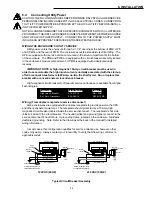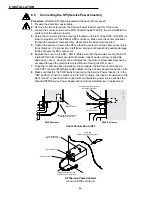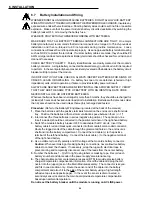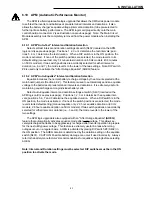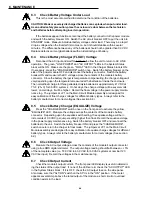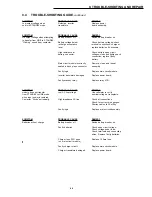
OPERATION
7.1
XM Power Module Start-up and Testing
Once connections have been made to the power module, it should be tested for AC
LINE and STANDBY operation before placing it into service. Note: The power module
should always be started from utility AC (not batteries). This is because high inrush
currents, associated with the start-up of ferroresonant transformers, could place unneces-
sary stress on the batteries.
7.1.1
AC Line Operation (LINE POWER)
1. Plug the module’s power cord into the enclosure's AC convenience outlet and switch
the AC circuit breaker ON. The green, front panel "LINE POWER" LED will light to
indicate AC LINE operation. The green "AC OUTPUT" LED will light as well to
indicate acceptable output voltage.
2. Wait at least 1 minute and then reset the battery breaker on the side panel.
3. Use a true RMS voltmeter to verify AC output at the module's AC OUTPUT connec-
tor. If a non-RMS voltmeter is used, the output reading can vary by as much as 10%
due to the "quasi" square wave output of the ferroresonant transformer.
4. Check the module's front panel "OUTPUT CURRENT DISPLAY" to verify output
current. Current is displayed in 2 Amp increments. When the output reading falls
between increments, adjacent LEDs light.
5. Check the "CHARGER STATUS" block. If necessary, press the "CHARGE MODE"
switch to place the charger into FLOAT. Once the green "FLOAT" LED lights, verify
the voltage at the module's "BATTERY" connector. It should closely match the
FLOAT setting on the main board assembly (section 6.9). Press the "CHARGE
MODE" switch again to place the charger into EQUALIZE. Once the yellow "EQUAL-
IZE" LED comes ON, verify the voltage at the "BATTERY" connector. The voltage
should closely match the "EQU" setting on the main circuit board assembly (section
6.9). Note: The battery charger is temperature-compensating so the voltages may
vary slightly, depending upon temperature. If the red "RECHARGE" LED is ON, the
batteries will be drawing more than 5 Amps of charge current.
6. On units equipped with an APM logic upgrade, press the "TEST/RESET" button
located in the APM status block to put the unit into self-test. The yellow "TEST IN
PROGRESS" LED
will come ON. If the logic card detects a problem, it will flash the
red "CHECK BATTERIES" or "CHECK INVERTER" LED to indicate the circuit that
has failed self-test. Press the "TEST/RESET" button once to cancel and return the
module to AC LINE operation.
7.1.2
Inverter Operation (STANDBY)
1. With the unit operating from AC LINE power, indicated by the green "LINE POWER"
and "AC OUTPUT" LEDs, switch the AC circuit breaker to OFF. The green "LINE
POWER" LED will go out and the red "STANDBY POWER" LED will come ON to
indicate inverter operation.
2. Use a true RMS voltmeter to verify AC at the module's "AC OUTPUT" connector.
3. Return the unit to AC LINE operation by switching the AC circuit breaker to ON. The
green "LINE POWER" LED will light, indicating that AC LINE power is again available.
It then takes 10 to 50 seconds for the unit to completely transfer back to utility power.
This delay allows the utility voltage and frequency to stabilize before the module’s
phase-lock circuitry is activated. The module then synchronizes the inverter’s wave-
form to the utility’s before initiating a smooth, in-phase transfer back to utility power.
Once the transfer is complete, the red "STANDBY POWER" LED will go out.
4. The XP Series power supply is now fully operational.
37
7. OPERATION

